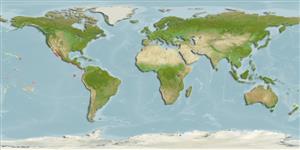>
Blenniiformes (Blennies) >
Blenniidae (Combtooth blennies) > Blenniinae
Etymology: Plagiotremus: Greek, plagios = oblique + Greek, trema = hole (Ref. 45335).
More on authors: Jordan & Bollman.
Environment: milieu / climate zone / depth range / distribution range
Ekologi
marina revassocierade; djupintervall 2 - 23 m (Ref. 5227). Tropical
Eastern Pacific: Gulf of California to Peru, including the Galapagos Islands (Ref. 5227).
Size / Vikt / Age
Maturity: Lm ? range ? - ? cm
Max length : 10.0 cm TL hane/ej könsbestämd; (Ref. 11482)
Adults live in empty tube-worm snail shells, often extending the head from the opening. They feed by joining loose groups of look-alike rainbow wrasse and darting out to nip at nearby fish, taking mucus and perhaps small bits of flesh (Ref. 5227). The skin of larger fishes is the mainstay of the diet, although they are also known to eat eggs (Ref. 28023). Oviparous (Ref. 205). Eggs are attached to the walls of the parent's shelter and are brooded by the male parent (Ref. 56053). Larvae are planktonic, often found in shallow, coastal waters (Ref. 94114).
Life cycle and mating behavior
Maturities | Reproduktion | Spawnings | Egg(s) | Fecundities | Larver
Oviparous, distinct pairing (Ref. 205). Males guard the eggs until they hatch (Ref. 56053).
Allen, G.R. and D.R. Robertson, 1994. Fishes of the tropical eastern Pacific. University of Hawaii Press, Honolulu. 332 p. (Ref. 11482)
IUCN Red List Status (Ref. 130435)
Threat to humans
Harmless
Human uses
Verktyg
Special reports
Download XML
Internet-källor
Estimates based on models
Preferred temperature (Ref.
123201): 22.5 - 29.1, mean 27.1 °C (based on 214 cells).
Phylogenetic diversity index (Ref.
82804): PD
50 = 0.5005 [Uniqueness, from 0.5 = low to 2.0 = high].
Bayesian length-weight: a=0.00562 (0.00258 - 0.01228), b=3.06 (2.87 - 3.25), in cm total length, based on LWR estimates for this (Sub)family-body shape (Ref.
93245).
Trofisk nivå (Ref.
69278): 4.4 ±0.78 se; based on food items.
Resiliens (Ref.
120179): Hög, lägsta populationsfördubblingstid mindre än 15 månader (Preliminary K or Fecundity.).
Fishing Vulnerability (Ref.
59153): Low vulnerability (10 of 100).
Nutrients (Ref.
124155): Calcium = 128 [65, 229] mg/100g; Iron = 0.812 [0.458, 1.384] mg/100g; Protein = 18.6 [17.5, 19.7] %; Omega3 = 0.112 [0.060, 0.208] g/100g; Selenium = 21.2 [10.0, 49.6] μg/100g; VitaminA = 264 [93, 733] μg/100g; Zinc = 1.46 [0.93, 2.17] mg/100g (wet weight);
